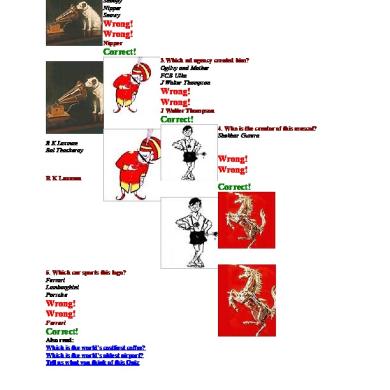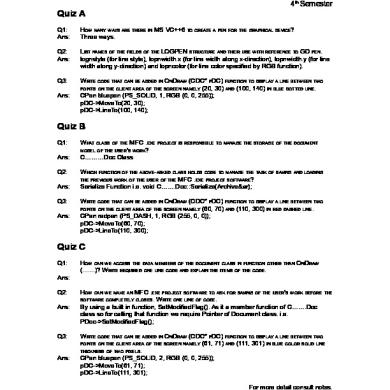(9)answers To Quiz 9.doc
This document was uploaded by user and they confirmed that they have the permission to share it. If you are author or own the copyright of this book, please report to us by using this DMCA report form. Report DMCA
Overview
Download & View (9)answers To Quiz 9.doc as PDF for free.
More details
- Words: 616
- Pages: 2
Answers to the questions in Quiz 9: 1. Clearly explain why the unemployment rate is an imperfect measure of joblessness. Answer: In general, the unemployment rate (reported by the government) is a useful measure of joblessness, but it is not a perfect measure for the reasons below:
There may be individuals who are calling themselves unemployed to receive government assistance, yet they are not trying hard to find work. This overstates the number of unemployed.
There may be individuals who would like to work but have given up looking for a job after an unsuccessful search. These individuals (called discouraged workers) will not be counted as part of the labor force. Therefore, while they are likely a part of the unemployed, they will not show up in the unemployment rate. This understates the number of unemployed.
2. List the two types of unemployment that an economy normally experiences in the long-run.
Answer: Frictional unemployment and structural unemployment.
3. Clearly explain why the economy experiences frictional unemployment.
Answer: Frictional unemployment refers to the unemployment that results because it takes time for workers to search for the jobs that best suit their tastes and skills.
4. Clearly explain why the economy experiences structural unemployment.
Answer: Structural unemployment refers to the unemployment which results because the number of jobs available in some labor markets is insufficient for everyone who wants a job to get one. Structural unemployment is due to above-equilibrium wages, including minimum wages (required by law), union wages, and efficiency wages.
5. Define efficiency wages.
Answer: Definition of efficiency wages: above-equilibrium wages paid by firms in order to increase worker productivity.
6. List the four reasons why some firms are willing to pay efficiency wages.
Answer: Some firms find it profitable to pay efficiency (or higher than equilibrium wage) to increase worker productivity and to reduce hiring, training, and monitoring costs. Reasons for firms to pay efficiency wages include:
1
Worker Health: better-paid workers can afford to eat better and can afford good medical care. This, especially in developing countries, can raise the productivity of workers. Worker Turnover: a firm can reduce turnover by paying a wage greater than its workers could receive elsewhere. This is especially helpful for firms that have high hiring and training costs. Worker Effort: if a firm pays a worker more than he or she can receive elsewhere, the worker will be more likely to try to protect his or her job by working harder. This is especially helpful for firms who have difficulty monitoring their workers. Worker Quality: offering higher wages attracts a better pool of applicants.
7. Use the figure below to show how unemployment occurs due to union wages. Label the axes and curves.
8. Clearly explain the difference between the natural and cyclical rate of unemployment.
Answer: Natural unemployment refers to the unemployment that the economy normally experiences in the long-run (and it includes both frictional unemployment and structural unemployment). Cyclical unemployment is the short-run deviations of the actual unemployment from the natural unemployment. Cyclical unemployment is due to business cycles. When the economy is in a period of recession, the actual unemployment rate is above the natural rate of unemployment. When the economy is in a period of boom, the actual unemployment rate is below the natural rate of unemployment.
9. Find the labor force and the unemployment rate in 2013. Show your calculations.
Answer: Labor force = 576 + 24 = 600 million people; Unemployment rate = (24/600) ×100 = 4%;
10. Find the labor-force participation rate in 2013. Show your calculations.
Answer: Labor-force participation rate = (600/857) ×100 = 70%.
2
There may be individuals who are calling themselves unemployed to receive government assistance, yet they are not trying hard to find work. This overstates the number of unemployed.
There may be individuals who would like to work but have given up looking for a job after an unsuccessful search. These individuals (called discouraged workers) will not be counted as part of the labor force. Therefore, while they are likely a part of the unemployed, they will not show up in the unemployment rate. This understates the number of unemployed.
2. List the two types of unemployment that an economy normally experiences in the long-run.
Answer: Frictional unemployment and structural unemployment.
3. Clearly explain why the economy experiences frictional unemployment.
Answer: Frictional unemployment refers to the unemployment that results because it takes time for workers to search for the jobs that best suit their tastes and skills.
4. Clearly explain why the economy experiences structural unemployment.
Answer: Structural unemployment refers to the unemployment which results because the number of jobs available in some labor markets is insufficient for everyone who wants a job to get one. Structural unemployment is due to above-equilibrium wages, including minimum wages (required by law), union wages, and efficiency wages.
5. Define efficiency wages.
Answer: Definition of efficiency wages: above-equilibrium wages paid by firms in order to increase worker productivity.
6. List the four reasons why some firms are willing to pay efficiency wages.
Answer: Some firms find it profitable to pay efficiency (or higher than equilibrium wage) to increase worker productivity and to reduce hiring, training, and monitoring costs. Reasons for firms to pay efficiency wages include:
1
Worker Health: better-paid workers can afford to eat better and can afford good medical care. This, especially in developing countries, can raise the productivity of workers. Worker Turnover: a firm can reduce turnover by paying a wage greater than its workers could receive elsewhere. This is especially helpful for firms that have high hiring and training costs. Worker Effort: if a firm pays a worker more than he or she can receive elsewhere, the worker will be more likely to try to protect his or her job by working harder. This is especially helpful for firms who have difficulty monitoring their workers. Worker Quality: offering higher wages attracts a better pool of applicants.
7. Use the figure below to show how unemployment occurs due to union wages. Label the axes and curves.
8. Clearly explain the difference between the natural and cyclical rate of unemployment.
Answer: Natural unemployment refers to the unemployment that the economy normally experiences in the long-run (and it includes both frictional unemployment and structural unemployment). Cyclical unemployment is the short-run deviations of the actual unemployment from the natural unemployment. Cyclical unemployment is due to business cycles. When the economy is in a period of recession, the actual unemployment rate is above the natural rate of unemployment. When the economy is in a period of boom, the actual unemployment rate is below the natural rate of unemployment.
9. Find the labor force and the unemployment rate in 2013. Show your calculations.
Answer: Labor force = 576 + 24 = 600 million people; Unemployment rate = (24/600) ×100 = 4%;
10. Find the labor-force participation rate in 2013. Show your calculations.
Answer: Labor-force participation rate = (600/857) ×100 = 70%.
2
Related Documents

Suse 9doc
November 2019 18
Answers To Quiz 2
December 2019 22
Quiz
November 2019 39
Quiz
May 2020 34
Quiz
November 2019 35
Quiz
May 2020 33More Documents from ""

(12)answers To Quiz 12.doc
November 2019 14
(9)answers To Quiz 9.doc
November 2019 19
(13)answers To Quiz 13.doc
November 2019 16
(11)answers To Quiz 11.docx
November 2019 13
(10)answers To Quiz 10.doc
November 2019 13